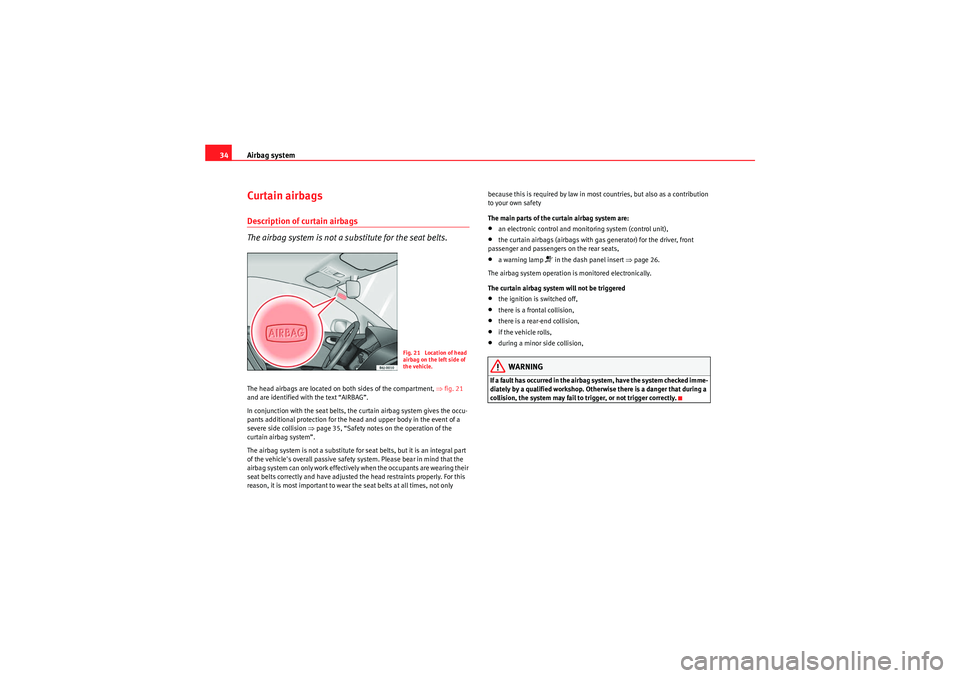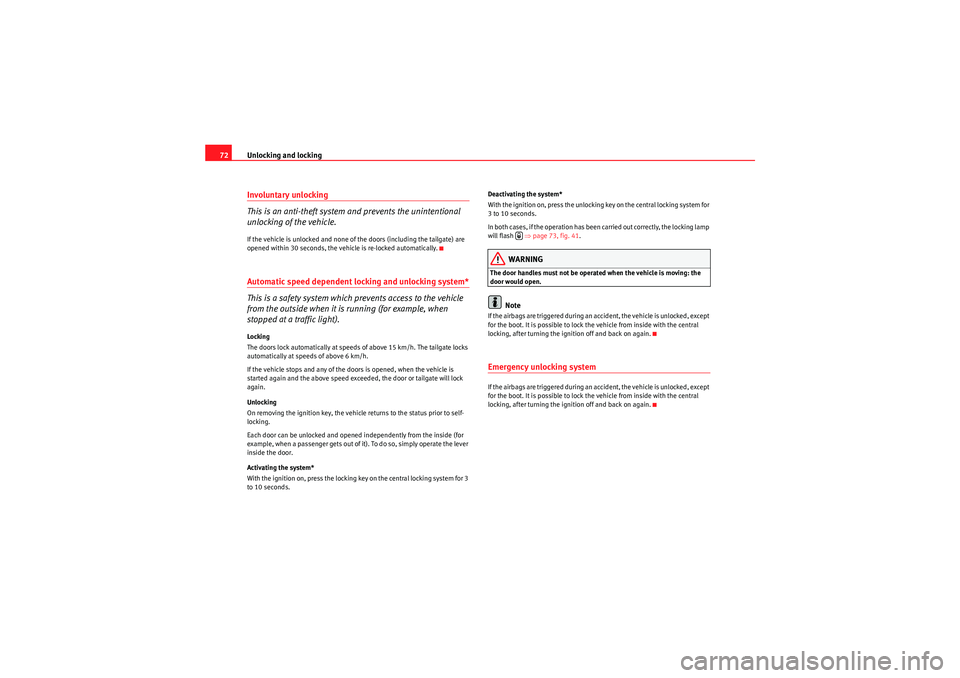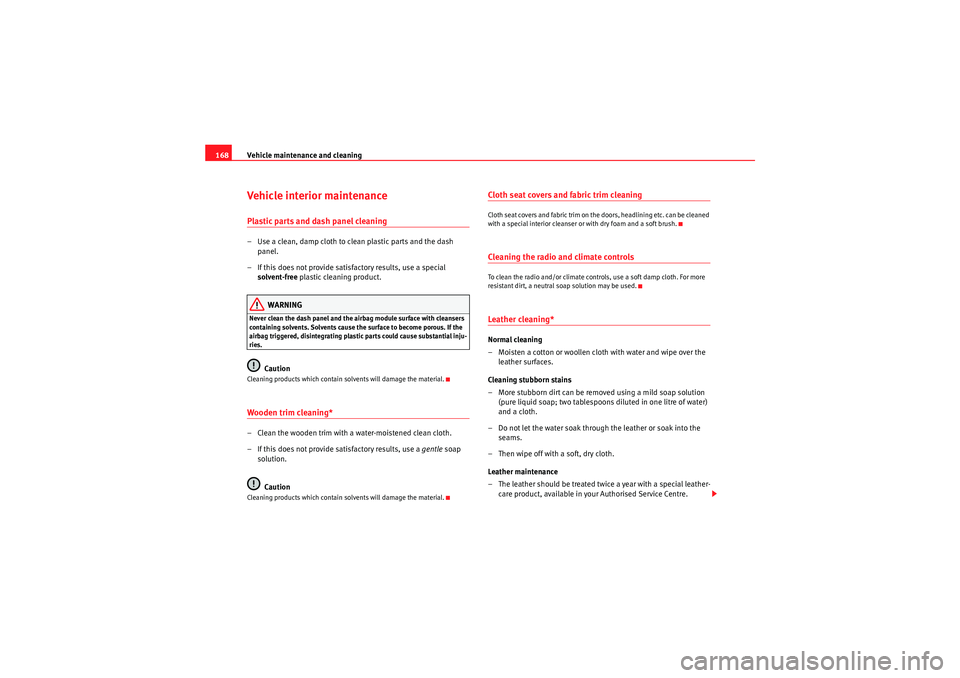2009 Seat Ibiza 5D airbag off
[x] Cancel search: airbag offPage 36 of 257

Airbag system
34Curtain airbagsDescription of curtain airbags
The airbag system is not a substitute for the seat belts.The head airbags are located on both sides of the compartment, ⇒fig. 21
and are identified with the text “AIRBAG”.
In conjunction with the seat belts, the curtain airbag system gives the occu-
pants additional protection for the he ad and upper body in the event of a
severe side collision ⇒page 35, “Safety notes on the operation of the
curtain airbag system”.
The airbag system is not a substitute for seat belts, but it is an integral part
of the vehicle's overall passive safety system. Please bear in mind that the
airbag system can only work effectively when the occupants are wearing their
seat belts correctly and have adjusted the head restraints properly. For this
reason, it is most important to wear the seat belts at all times, not only because this is required by law in most countries, but also as a contribution
to your own safety
The main parts of the curtain airbag system are:
•an electronic control and monitoring system (control unit),•the curtain airbags (airbags with gas generator) for the driver, front
passenger and passengers on the rear seats,•a warning lamp
in the dash panel insert ⇒page 26.
The airbag system operation is monitored electronically.
The curtain airbag system will not be triggered
•the ignition is switched off,•there is a frontal collision,•there is a rear-end collision,•if the vehicle rolls,•during a minor side collision,WARNING
If a fault has occurred in the airbag system, have the system checked imme-
diately by a qualified workshop. Otherwise there is a danger that during a
collision, the system may fail to trigger, or not trigger correctly.
Fig. 21 Location of head
airbag on the left side of
the vehicle.
Ibiza_EN.book Seite 34 Montag, 14. September 2009 6:19 18
Page 38 of 257

Airbag system
36•Do not attempt to modify components of the airbag system in any way.•To ensure the correct functioning of the side and head airbags neither
the doors nor the door panels should be modified in any way (e.g. fitting
loudspeakers). If the front door is damaged, the airbag system may not
work correctly. All work carried out on the front door must be made in a
qualified workshop.
Deactivating airbags*Disabling front passenger airbag
If you fit a rear-facing child seat to the front passenger seat,
the front passenger airbag must be de-activated.
When the passenger airbag is deactivated, this means that only the
front passenger's front airbag is deactivated. All the other airbags in
the vehicle remain functional.
Disabling front passenger airbag
– Switch the ignition off.
– Turn the ignition switch in the key operated switch in the glove box to the position OFF ⇒ fig. 23 .
– Check that the warning lamp “AIRBAG OFF” on the dash panel ⇒fig. 24 remains lit ⇒ when the ignition is switched on.
Enabling front passenger airbag
– Switch the ignition off.
– Turn the ignition key in the key-operated switch in the glove box to the position ON ⇒ fig. 23 .
WARNING (continued)
Fig. 23 In the glove box:
key for enabling and disa-
bling front passenger
airbag
Fig. 24 Warning lamp for
deactivated passenger
airbag in centre console
Ibiza_EN.book Seite 36 Montag, 14. September 2009 6:19 18
Page 39 of 257

Airbag system37
Safety First
Controls and equipment
Practical tips
Technical Data
– Check that the warning lamp “AIRBAG OFF” in the console does
⇒page 36, fig. 24 not light up when the ignition is switched on
⇒ .
WARNING
•The driver is responsible for the proper position of the key-operated
switch. •You should only disable the front passenger airbag when, in excep-
tional cases, you have to use a rear-facing child seat in the front passenger
seat ⇒page 38, “Child safety”•Never install a child seat facing backwards (or rear-facing) on the front
passenger seat unless the front passenger airbag has been disabled. This
represents a risk of fatal injuries to the child! However, if it is necessary in
exceptional circumstances to transport a child in a rear-facing child seat on
the front passenger seat, you must always disable the front passenger
airbag.•As soon as the child seat is no longer needed on the front passenger
seat, enable the front passenger airbag again.•Only deactivate the passenger airbag when the ignition is off, other-
wise a fault may occur in the airbag system, this will create a danger that
in case of an accident, the airbag does not deploy properly or does not
deploy at all.•When the passenger airbag is deactivated, if the warning lamp AIRBAG
OFF is not continuously lit up when the front passenger airbag is disabled,
there may be a fault in the airbag system:
−Have the airbag system inspected immediately by a qualified work-
shop.
− Do not use a child seat on the front passenger seat! The front
passenger airbag could be triggered despite the fact that there is a fault
in the system and, as a result, a child could sustain serious or fatal inju-
ries. −
It is predictable whether the front passenger airbag will deploy
during an accident! Warn all your passengers of this.
•When using the ignition key to activate / deactivate the passenger
frontal airbag, only the passenger frontal and side airbag will be activated
/ deactivated. The curtain airbag on the passenger side will remain
active.WARNING (continued)
Ibiza_EN.book Seite 37 Montag, 14. September 2009 6:19 18
Page 41 of 257

Child safety39
Safety First
Controls and equipment
Practical tips
Technical Data
“Deactivating airbags*”. If the passenger seat has a height adjustment
option, move it to the highest position.
•For those vehicles that do not include a key lock switch to turn the
airbag off, an Authorised Service Centre must be consulted.•All passengers, especially children, must assume the proper sitting
position and be properly belted in while travelling.•Never hold children or babies on your lap, this can result in potentially
fatal injuries to the child!•Never allow a child to be transported in a vehicle without being properly
secured, or to stand up or kneel on a seat while travelling. In an accident,
the child could be flung through the vehicle, causing possibly fatal injuries
to themselves and to the other passengers.•If children assume an improper sitting position when the car is moving,
they expose themselves to greater risk of injury in the event of sudden
braking manoeuvre or in an accident. This is particularly important if the
child is travelling on the front passenger seat and the airbag system is trig-
gered in an accident; as this could cause serious injury or even death.•A suitable child seat can protect your child!•Never leave an unsupervised child alone on a child seat or in the
vehicle.•Depending on weather conditions, it may become extremely hot or cold
inside the vehicle. This can be fatal.•Children who are less than 1.5 metres tall must not wear a normal seat
belt without a child restraint system, as this could cause injuries to the
abdominal and neck areas during a sudden braking manoeuvre or in an
accident.•Do not allow the belt webbing to become twisted or jammed, or to rub
on any sharp edges.•Incorrectly worn seat belts can cause injuries even in a minor collision
or in sudden braking manoeuvres.
•The seat belt provides maximum protection only when the belt web is
properly positioned ⇒page 20, “Seat belts”.•Only one child may occupy a child seat ⇒page 40, “Child seats”.
WARNING (continued)
WARNING (continued)
Ibiza_EN.book Seite 39 Montag, 14. September 2009 6:19 18
Page 74 of 257

Unlocking and locking
72Involuntary unlocking
This is an anti-theft system and prevents the unintentional
unlocking of the vehicle.If the vehicle is unlocked and none of the doors (including the tailgate) are
opened within 30 seconds, the vehicle is re-locked automatically.Automatic speed dependent locking and unlocking system*
This is a safety system which prevents access to the vehicle
from the outside when it is running (for example, when
stopped at a traffic light).Locking
The doors lock automatically at speeds of above 15 km/h. The tailgate locks
automatically at speeds of above 6 km/h.
If the vehicle stops and any of the doors is opened, when the vehicle is
started again and the above speed exceeded, the door or tailgate will lock
again.
Unlocking
On removing the ignition key, the vehicle returns to the status prior to self-
locking.
Each door can be unlocked and opened independently from the inside (for
example, when a passenger gets out of it). To do so, simply operate the lever
inside the door.
Activating the system*
With the ignition on, press the locking key on the central locking system for 3
to 10 seconds. Deactivating the system*
With the ignition on, press the unlocking key on the central locking system for
3 to 10 seconds.
In both cases, if the operation has been carried out correctly, the locking lamp
will flash ⇒
page 73, fig. 41 .
WARNING
The door handles must not be operated when the vehicle is moving: the
door would open.
Note
If the airbags are triggered during an accident, the vehicle is unlocked, except
for the boot. It is possible to lock the vehicle from inside with the central
locking, after turning the ignition off and back on again.Emergency unlocking systemIf the airbags are triggered during an accident, the vehicle is unlocked, except
for the boot. It is possible to lock the vehicle from inside with the central
locking, after turning the ignition off and back on again.
Ibiza_EN.book Seite 72 Montag, 14. September 2009 6:19 18
Page 103 of 257

Seats and stowage101
Safety First
Controls and equipment
Practical tips
Technical Data
Seats and stowageThe importance of correct seat adjustmentProper seat adjustment optimises the level of protection
offered by seat belts and airbags.Your vehicle has five seats, two on the front part and three on the rear part.
Each seat is equipped with a three-point seat belt.
The driver seat and the front passenger seat can be adjusted in many ways to
suit the physical requirements of the vehicle occupants. The correct seat
position is very important for:•a fast and easy operation of all controls on the instrument panel,•a relaxed posture which does not cause drowsiness,•a safe driving ⇒ page 7,•ensuring that the seat belts and airbag system provide maximum protec-
tion ⇒page 16.WARNING
•If the driver and passengers assume improper sitting positions, they
may sustain critical injuries.•More people than available seats must never be transported in your
vehicle.•Every passenger in the vehicle must properly fasten and wear the seat
belt belonging to his or her seat. Chil dren must be protected with an appro-
priate child restraint system ⇒page 38, “Child safety”.•The front seats and all head restraints must always be adjusted to body
size and the seat belt must always be properly adjusted to provide you and
your passengers with optimum protection.
•Always keep your feet on the foot well when the vehicle is moving;
never rest them on the dash panel, out of the window or on the seat. This
is also applied to passengers. An incorrect sitting position exposes you to
an increased risk of injury in case of a sudden braking or an accident. If the
airbag is triggered, you could sustain severe injuries due to an incorrect
sitting position.•It is important for the driver and front passenger to keep a distance of
at least 25 cm from the steering wheel or dash panel. Failure to respect the
minimum distance means that the airbag will not protect you. Risk of fatal
injury. The distance between the driver and the steering wheel or between
the front passenger and the dash panel should always be as great as
possible.•Adjust the driver or front passenger seat only when the vehicle is
stationary. Otherwise, your seat could move unexpectedly while the
vehicle is moving. This could increase the risk of an accident and therefore,
injury. In addition, while adjusting your seat, you will assume an incorrect
sitting position. Risk of fatal accidents.•Special guidelines apply to installing a child seat on the front
passenger seat. When installing a child seat, please observe the warnings
described in ⇒page 38, “Child safety”.WARNING (continued)
Ibiza_EN.book Seite 101 Montag, 14. September 2009 6:19 18
Page 141 of 257

Driving139
Safety First
Controls and equipment
Practical tips
Technical Data
N - Neutral (idling)
If this position is selected, the gearbox is in neutral. Power is not transmitted
to the wheels and the engine does not have a braking function.
Never use the
N position to drive down a hill. The engine does not function as
a brake and the brakes are subjected to excessive stain.
You could damage the automatic gearbox if you drive down hills with the
selector lever in position N and the engine switched off.
D - Drive (forwards)
In this position the gearbox automatically changes to a lower or higher gear,
according to the engine requirements, driving style and speed. The braking
effect of the engine when driving downhill is very limited when the selector is
in this position. The instrument panel screen displays the selected gear as
well as the selector lever in position D.
If position N has been selected and you wish to select D, you must press the
foot brake if the vehicle is stationary, or travelling at under 5 km/h.
S - Standard driving position (Sport programme)
When the selector lever is in position S, it will automatically change up into a
h igh er gea r late r, an d change d own i nto a low g ea r, if com pare d wi th p osi ti on
D . This way, it is possible to take full advantage of the engine reserve power,
depending on the engine demand, driving style and speed. The braking
effect of the engine when driving downhill is very limited. On the instrument
panel screen the selected gear is shown as well as the selector lever to posi-
tion S.
To select gear range S, press the lock button on the selector lever.
WARNING
If the vehicle moves with no control, an accident and serious injury may
occur.•As a driver, you should never leave your vehicle if the engine is running
and a gear is engaged. If you have to leave your vehicle while the engine is running, you must always apply the parking brake and engage parking lock
P.
•If the engine is running and if D or R are engaged, you will need to hold
the vehicle stopped by depressing footbrake down. The car would creep
forward as the power transmission is not fully interrupted even when the
engine is idling.•Never accelerate when changing gear or you may cause an accident.•Never move the selector lever to “R” or “P” when driving. Risk of acci-
dent.•Before driving down a very steep slope, reduce your speed and shift to
position 1st.•Always hold the vehicle on the foot brake if you stop uphill. Otherwise,
the vehicle could roll back.•Never allow the brake to rub and do not use the brake pedal too often
or for long periods. Constant braking will cause the brakes to overheat and
will considerably reduce the braking effect. This increases the braking
distance and could cause the brake system to fail.WARNING
Never switch the engine off until the vehicle is stationary. You could lose
control of your vehicle. This could cause an accident and serious injury.•The airbags and belt tensioners do not work when the ignition is
switched off.•The brake servo does not work when the engine is not running. You
need more force to stop the vehicle.•Power assisted steering does not work when the engine is not running.
That is why it is much more difficult to turn the steering wheel.•Never remove the key from the ignition if the vehicle is in motion. The
steering lock could suddenly engage, and you would not be able to steer
the vehicle.WARNING (continued)
Ibiza_EN.book Seite 139 Montag, 14. September 2009 6:19 18
Page 170 of 257

Vehicle maintenance and cleaning
168Vehicle interior maintenancePlastic parts and dash panel cleaning– Use a clean, damp cloth to clean plastic parts and the dash
panel.
– If this does not provide satisfactory results, use a special solvent-free plastic cleaning product.
WARNING
Never clean the dash panel and the airbag module surface with cleansers
containing solvents. Solvents cause the surface to become porous. If the
airbag triggered, disintegrating plastic parts could cause substantial inju-
ries.
Caution
Cleaning products which contain solvents will damage the material.Wooden trim cleaning*– Clean the wooden trim with a water-moistened clean cloth.
– If this does not provide satisfactory results, use a gentle soap
solution.
CautionCleaning products which contain solvents will damage the material.
Cloth seat covers and fabric trim cleaningCloth seat covers and fabric trim on the doors, headlining etc. can be cleaned
with a special interior cleanser or with dry foam and a soft brush.Cleaning the radio and climate controlsTo clean the radio and/or climate controls, use a soft damp cloth. For more
resistant dirt, a neutral soap solution may be used.Leather cleaning*Normal cleaning
– Moisten a cotton or woollen cloth with water and wipe over the leather surfaces.
Cleaning stubborn stains
– More stubborn dirt can be removed using a mild soap solution (pure liquid soap; two tablespoons diluted in one litre of water)
and a cloth.
– Do not let the water soak through the leather or soak into the seams.
– Then wipe off with a soft, dry cloth.
Leather maintenance
– The leather should be treated twice a year with a special leather- care product, available in your Authorised Service Centre.
Ibiza_EN.book Seite 168 Montag, 14. September 2009 6:19 18